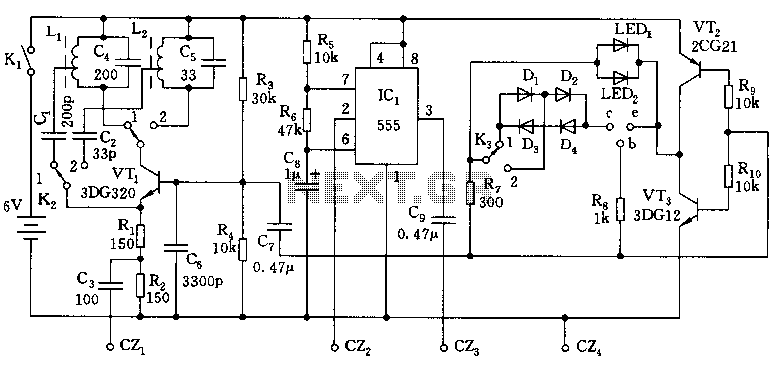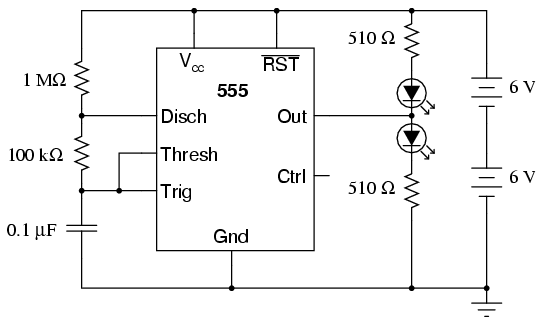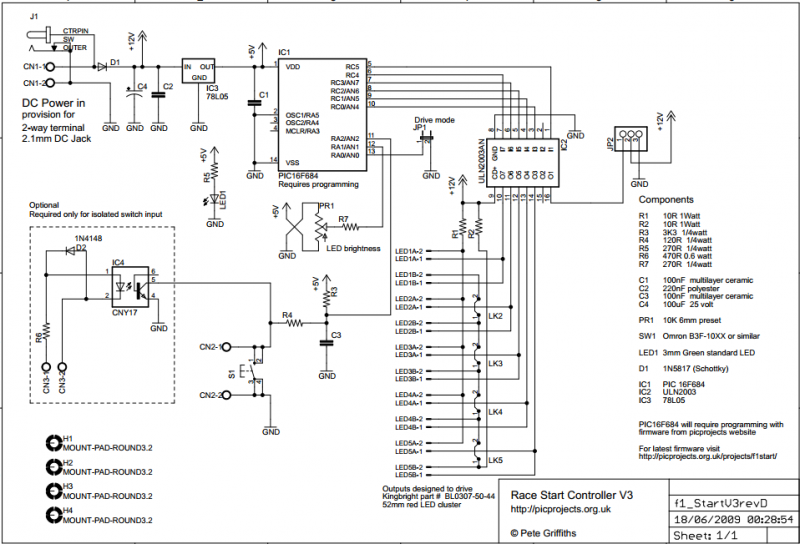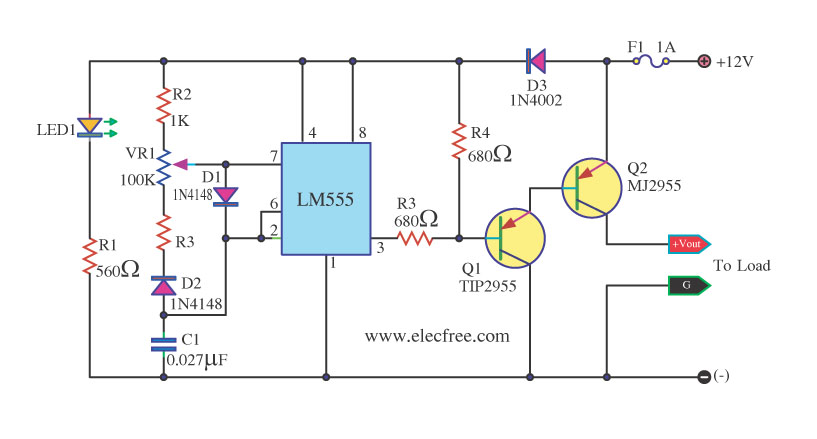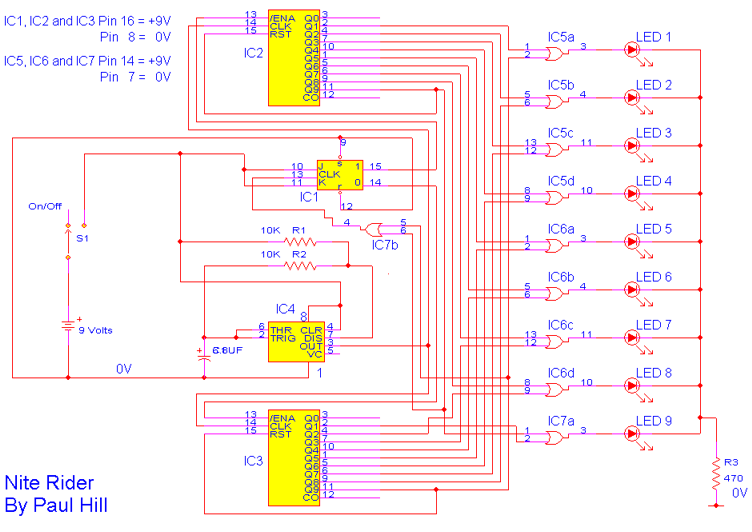
555 Christmas Lights Project
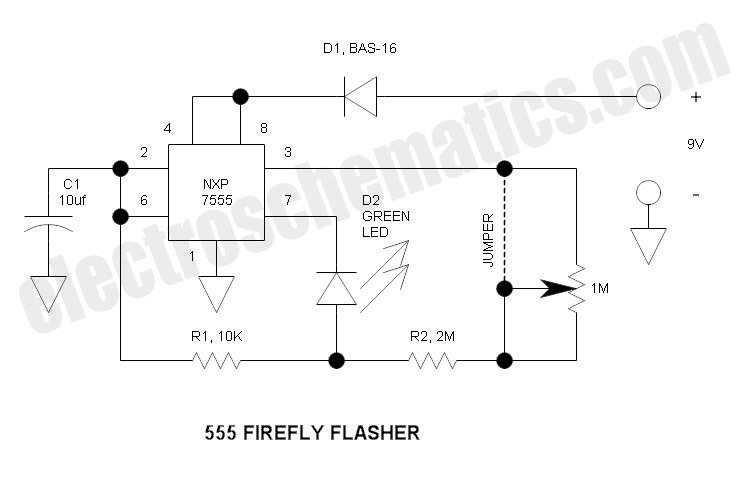
This circuit differs from the standard 555 oscillator circuit by placing the LED in the capacitor reset line (pin 7). This configuration reduces overall current and prevents high peak LED current from draining the battery. The forward voltage drop of the LED can affect the reset threshold voltage when the battery voltage is low, so the capacitor charge source is connected via pin 3, the output. While the capacitor resets quickly through pin 7, it is also slowly discharged through pin 3, assisting in maintaining the capacitor voltage above the reset threshold (3V or lower). The total current drain is approximately 500 µA, allowing a 9V battery to power the circuit for months. A 12V supply offers brighter output but is less convenient due to the scarcity of small 12V batteries. Each section of the circuit can operate independently and includes a reverse polarity diode to prevent damage from incorrect battery connections. The circuit can be assembled in strips of four or six flashers, with each section being interconnected. Three ExpressPCB mini-boards can accommodate a total of 18 four-position or 12 six-position flashers. The prototype includes four different LED colors, although the bill of materials (BOM) lists six colors. It is possible to source alternative colors. The selected capacitor, C1, is 10 µF for brighter LEDs like white, blue, and green. To equalize brightness among dimmer LEDs, two 10 µF capacitors can be combined for a total of 20 µF. This project allows students to learn about identifying, handling, soldering small surface-mount devices (SMDs), and performing testing. The smallest device size is 0805, which is manageable for most individuals. Smaller sizes, such as 0603 or 0402, are generally considered impractical for hand assembly. The completed circuit serves as an interesting artifact that is unlikely to be discarded. Purchasing components in bulk for group projects can significantly reduce costs.
The circuit operates based on the 555 timer's functionality, configured in astable mode for continuous oscillation. The LED's placement in the reset line (pin 7) is a unique approach that provides a dual function: it prevents excessive current draw from the battery while ensuring that the capacitor can discharge adequately. The use of pin 3 as a charge source facilitates a smoother transition during the reset phase, allowing the capacitor to maintain a voltage level conducive to reliable operation.
The reverse polarity diode is a critical safety feature, safeguarding the circuit against damage from incorrect battery installation. The design encourages modularity, enabling the assembly of multiple sections into a single unit, thus providing flexibility in application. The choice of capacitors and their arrangement directly impacts the brightness and performance of the LEDs, making it essential to select components based on the desired outcome.
The project serves as an educational tool, allowing participants to gain hands-on experience with SMD technology and circuit assembly. The emphasis on using commonly available components, such as 0805-sized SMDs, ensures that the project remains accessible to a wide audience. Overall, this circuit design exemplifies innovative thinking in optimizing the use of standard electronic components while providing a platform for learning and experimentation.This is different than the standard 555 oscillator circuit in that the LED is placed in the capacitor reset line (pin 7). By doing so, overall current is reduced and the high peak LED current does not flow out of the battery.
Since the forward drop of the LED can interfere with the reset threshold voltage when the battery voltage is low, the capac itor charge source is via pin 3, the output. In this way, while the capacitor is rapidly resetting via pin 7, it is also being slowly discharged via pin 3 that follows pin 7. That way if the capacitor voltage has a difficult time discharging to the reset voltage (3V or lower), it has a little help via the charge source.
Total current drain is in the order of 500uA. A 9V battery can power this for months. 12V is brighter but less convenient because small 12V batteries are uncommon. Each section can stand alone and has an individual reverse polarity diode. You may think that this diode may be eliminated, but destruction is instant if the battery is accidentally connected reverse. This can be assembled either in a strip of (4) or (6) flashers ” all (6) sections are bussed together.
Three expresspcb. com miniboards yield a total of 18 (4) position, or 12 (6) position flashers. My prototype has (4) different LED colors, but the BOM lists (6) LED colors. Perhaps you can locate other colors you like better. I actually purchased my LEDs on eBay ”they have some good deals. C1 is 10uF for bright LEDs such as White, Blue and Green ”to help equalize brightness for dimmer LEDs, I simply piggybacked (2) 10uF capacitors to get 20uF. As a group project, students can learn how to identify, handle and solder small SMD devices, and test.
The smallest device is the common 0805 size and even I (at my age) can handle this stuff. Smaller sizes such as 0603 or 0402 is electronic dust in my opinion and do not lend itself to hand assembly. The finished piece is an interesting curio that will not get discarded. Purchasing all components for a group gets the volume up and price is significantly reduced. For unto you is born this day in the city of David a Saviour, which is Christ the Lord. And this shall be a sign unto you; Ye shall find the babe wrapped in swaddling clothes, lying in a manger.
And suddenly there was with the angel a multitude of the heavenly host praising God, and saying, Glory to God in the highest, and on earth peace, good will toward men. Luke 2. 11-14 (KJV) 🔗 External reference
The circuit operates based on the 555 timer's functionality, configured in astable mode for continuous oscillation. The LED's placement in the reset line (pin 7) is a unique approach that provides a dual function: it prevents excessive current draw from the battery while ensuring that the capacitor can discharge adequately. The use of pin 3 as a charge source facilitates a smoother transition during the reset phase, allowing the capacitor to maintain a voltage level conducive to reliable operation.
The reverse polarity diode is a critical safety feature, safeguarding the circuit against damage from incorrect battery installation. The design encourages modularity, enabling the assembly of multiple sections into a single unit, thus providing flexibility in application. The choice of capacitors and their arrangement directly impacts the brightness and performance of the LEDs, making it essential to select components based on the desired outcome.
The project serves as an educational tool, allowing participants to gain hands-on experience with SMD technology and circuit assembly. The emphasis on using commonly available components, such as 0805-sized SMDs, ensures that the project remains accessible to a wide audience. Overall, this circuit design exemplifies innovative thinking in optimizing the use of standard electronic components while providing a platform for learning and experimentation.This is different than the standard 555 oscillator circuit in that the LED is placed in the capacitor reset line (pin 7). By doing so, overall current is reduced and the high peak LED current does not flow out of the battery.
Since the forward drop of the LED can interfere with the reset threshold voltage when the battery voltage is low, the capac itor charge source is via pin 3, the output. In this way, while the capacitor is rapidly resetting via pin 7, it is also being slowly discharged via pin 3 that follows pin 7. That way if the capacitor voltage has a difficult time discharging to the reset voltage (3V or lower), it has a little help via the charge source.
Total current drain is in the order of 500uA. A 9V battery can power this for months. 12V is brighter but less convenient because small 12V batteries are uncommon. Each section can stand alone and has an individual reverse polarity diode. You may think that this diode may be eliminated, but destruction is instant if the battery is accidentally connected reverse. This can be assembled either in a strip of (4) or (6) flashers ” all (6) sections are bussed together.
Three expresspcb. com miniboards yield a total of 18 (4) position, or 12 (6) position flashers. My prototype has (4) different LED colors, but the BOM lists (6) LED colors. Perhaps you can locate other colors you like better. I actually purchased my LEDs on eBay ”they have some good deals. C1 is 10uF for bright LEDs such as White, Blue and Green ”to help equalize brightness for dimmer LEDs, I simply piggybacked (2) 10uF capacitors to get 20uF. As a group project, students can learn how to identify, handle and solder small SMD devices, and test.
The smallest device is the common 0805 size and even I (at my age) can handle this stuff. Smaller sizes such as 0603 or 0402 is electronic dust in my opinion and do not lend itself to hand assembly. The finished piece is an interesting curio that will not get discarded. Purchasing all components for a group gets the volume up and price is significantly reduced. For unto you is born this day in the city of David a Saviour, which is Christ the Lord. And this shall be a sign unto you; Ye shall find the babe wrapped in swaddling clothes, lying in a manger.
And suddenly there was with the angel a multitude of the heavenly host praising God, and saying, Glory to God in the highest, and on earth peace, good will toward men. Luke 2. 11-14 (KJV) 🔗 External reference
Warning: include(partials/cookie-banner.php): Failed to open stream: Permission denied in /var/www/html/nextgr/view-circuit.php on line 713
Warning: include(): Failed opening 'partials/cookie-banner.php' for inclusion (include_path='.:/usr/share/php') in /var/www/html/nextgr/view-circuit.php on line 713
